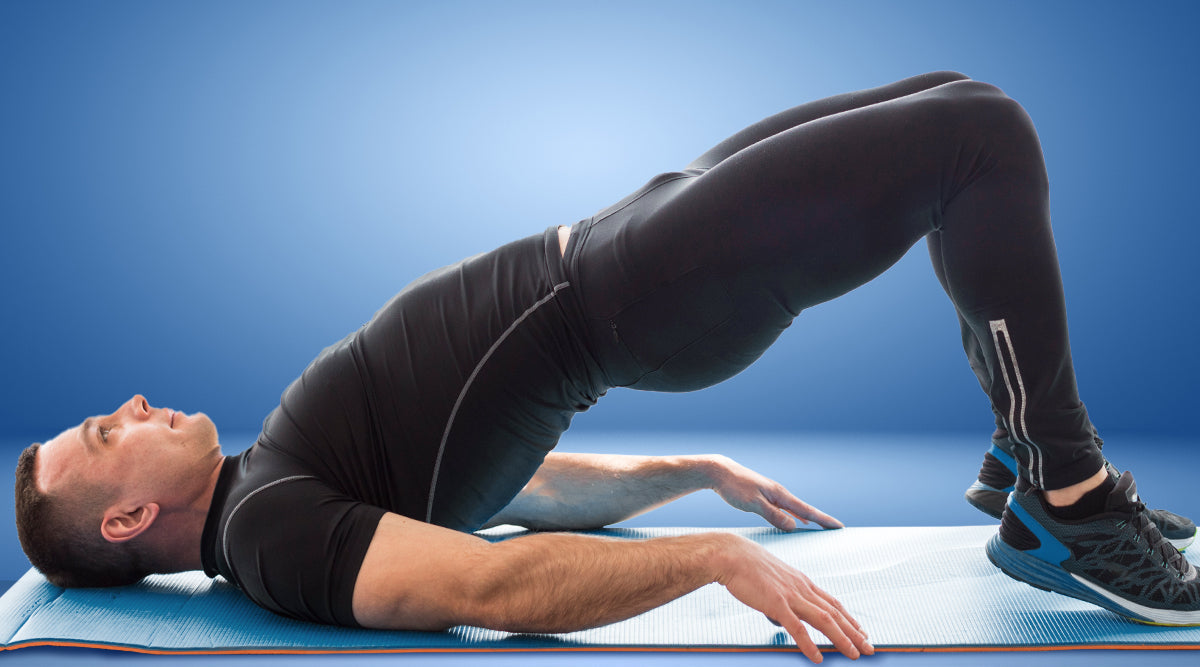How It Works Mobile
Health Benefits Mobile

How to Find Your Pelvic Floor Muscles
How to Find Your Pelvic Floor Muscles
5 min read
5 min read
The pelvic muscles are essential for bladder control, sexual performance, and overall core stability. In men, these muscles support the bladder, bowel, and prostate, forming a crucial part of the pelvic floor area. Strengthening them through pelvic floor exercises can significantly improve these functions, enhancing one’s quality of life.
Despite their importance, many men struggle to identify their pelvic muscles. Performing pelvic floor exercises becomes challenging without properly locating these muscles, leading to ineffective workouts and missed health benefits.
Knowing how to locate and engage your pelvic muscles is essential for improving your sexual health. This article will help you understand pelvic muscles, how to find them, and how to ensure you’re performing Kegel exercises correctly.
What Are Pelvic Floor Muscles in Men?

Pelvic muscles, also known as the pelvic floor muscles, are a group of muscles stretching across the pelvis’s base. These muscles form a sling-like structure that supports the bladder, bowel, and prostate.
They play a crucial role in maintaining continence and enhancing sexual health by holding the pelvic organs in place and assisting in their proper function. Understanding pelvic floor function is essential for maintaining continence and enhancing sexual health.
The major muscles of the pelvic floor include the pubococcygeus, iliococcygeus, and puborectalis. The pubococcygeus muscle stretches from the pubic bone to the tailbone, supporting the pelvic organs. The iliococcygeus muscle extends from the pelvic bone to the coccyx, helping maintain continence and support pelvic organs. The puborectalis muscle forms a loop around the rectum, controlling the release of urine and feces.
These muscles work together to support the organs, control the release of urine and feces, and contribute to sexual function. A strong pelvic floor helps prevent urinary incontinence, improve erectile function, and maintain overall pelvic health. Weak or damaged pelvic muscles can lead to various issues, such as urinary incontinence, erectile dysfunction, premature ejaculation, and pelvic organ prolapse.
Strengthening these muscles through targeted exercises can significantly improve these functions and enhance your quality of life.
How to Identify Your Pelvic Muscles

Identifying your pelvic muscles, or learning how to identify your pelvic floor, is the first step towards strengthening them. Here are some effective methods to help you locate these important muscles:
Method 1: Stopping Urine Flow
One simple way to identify your pelvic muscles is to stop urine flow while urinating. Midway through urination, try to halt the stream. The muscles you use to achieve this are your pelvic muscles.
However, don’t habitually stop your urine flow regularly, which can cause urinary problems. Use this method only to locate the muscles.
Method 2: Visual and Physical Cues
Using visual and physical cues can also be very helpful in identifying your pelvic muscles. Stand in front of a mirror and observe the area between your scrotum and anus, known as the perineum. You should see a slight lift in this area when you contract your pelvic muscles.
Additionally, you can use a clean finger to feel the muscle contraction. Insert your finger into your anus and try to squeeze around it without engaging your buttock or thigh muscles. This physical feedback can help you target the correct muscles and avoid engaging the wrong ones.
Using these methods, you can effectively locate your pelvic muscles, the first step towards strengthening and improving your pelvic health.

Online Kegel Exercise Program
Expert-designed Kegel training for men to strengthen pelvic muscles, improve stamina, and support sexual health—all from home.

Kegel Exercise Program for Men
Clinically proven system with resistance training exercises to maximize pelvic strength, stamina, and erection quality.

Male Pelvic Fitness Book
Expert insights on strengthening pelvic muscles, improving sexual health, and enhancing performance through science-backed techniques.
How to Be Sure You’re Doing Pelvic Floor Muscle Exercises Correctly

Correctly performing Kegel exercises, or pelvic floor muscle exercises, is crucial for effectively strengthening your pelvic muscles. Here are some tips to ensure you use the proper technique:
Isolate the Pelvic Muscles
Make sure you are only tightening your pelvic muscles. Avoid contracting your abdominal muscles, thigh, or buttock muscles. To check this, place a hand on your abdomen to ensure it remains relaxed while exercising. This helps you focus on the correct muscle group and ensures you benefit most from the exercise.
Consistency
Practice Kegel exercises regularly. Use a professionally designed Kegel program, such as our Complete Training Program for Men, to ensure you get the most out of your Kegel exercises.
If you don't have one, aim to do three sets of 10-15 repetitions 3-4 times weekly. Consistency is key to seeing improvements. Set a routine that fits into your daily schedule, such as doing your Kegels while brushing your teeth or during your commute.
Regular practice will help you build strength over time. You may wonder how long it takes to see results from Kegels; typically, with consistent effort, you can start noticing improvements within a few weeks to a few months. Remember, patience and regular practice are essential for achieving the best results.
Proper Form for Pelvic Floor Exercises
Contract your pelvic muscles and hold the contraction for 3-5 seconds. Then, relax for the same amount of time. Gradually increase the duration as your muscles get stronger. Starting with shorter holds and gradually increasing the time helps prevent muscle fatigue and ensures steady progress.
Breathe Normally
Do not hold your breath or use your chest muscles while performing Kegels. Breathe freely and focus on the muscle contractions. Holding your breath can add unnecessary pressure to your abdomen and pelvic floor, making the exercises less effective. Maintaining a normal breathing pattern helps you stay relaxed and focused on the exercise.
Check for Fatigue
Take a break if you feel fatigued or notice your muscles weakening during the exercise. It’s important to avoid overdoing kegel exercises. Rest for a few minutes before resuming your exercises. Overexertion can lead to muscle strain, so listening to your body and allowing time for recovery is important.

The Penis Book
An expert guide covering size, function, health, and performance—everything you need to know for optimal penile wellness.

Ultimate Penis Workout
The ultimate clinically proven workout to maximize stamina, strengthen pelvic muscles, and enhance erection quality.

Primal Cold JetPack
Advanced cold therapy designed to boost testosterone, enhance fertility, and revitalize sexual energy with targeted cooling power.
Strengthen Your Pelvic Floor Muscles Safely with the Private Gym

Identifying and strengthening pelvic muscles is a vital aspect of men’s health that can lead to improved bladder control, enhanced sexual performance, and overall well-being. Pelvic floor muscle training is essential for improving bladder control and sexual performance. By understanding pelvic muscles and how to locate them, you can begin incorporating Kegel exercises into your routine to keep your pelvic floor muscles strong.
Effectively targeting and strengthening pelvic floor muscles is crucial for improving men's health, including better bladder control and enhanced sexual performance. By learning to identify and work out these muscles, you can incorporate Kegel exercises into your daily routine to maintain a robust pelvic floor and prevent problems like urinary incontinence and erectile dysfunction.
At Private Gym, we offer specialized sexual health programs to help men see real improvements. Our popular Kegel exercise program for men is crafted to ensure you engage the correct muscles and progress at a steady, safe pace. With the guidance of our sexual performance coaches, you can avoid overexertion and achieve stronger pelvic muscles, improved bladder control, and better sexual health more efficiently.
For more information on how our programs can enhance your sexual health and performance, reach out to us today and take the first step toward a healthier you!
RELATED ARTICLES

The Benefits of Kegels for Men
6 min read

Signs of Overdoing Kegel Exercises in Men
6 min read
Recent Articles
- 12 Types of Female Orgasms: How to Help Her Experience Each One
- Why I Recommend You Get a Tantric Couch
- The Downsides of Penis Enlargement Surgery: Risks and Alternatives
- Bathmate vs. Air Pumps
- Bathmate Results: Penis Pump Before & After
- Side Effects of Catuaba
- Health Benefits of Catuaba
- 12 Essential Tips for a Healthy Penis
- Can Quadriplegic Men Have Sex?
- Sexual Function for Men After Spinal Cord Injury































